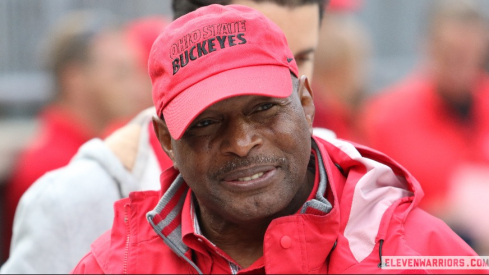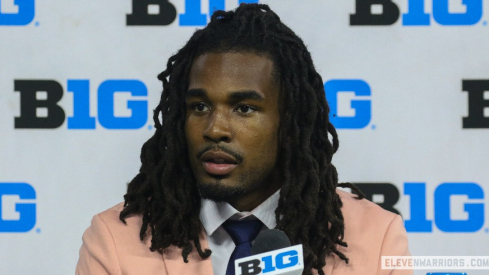
In Cal, the Ohio State offense again faced a defensive game plan that they did not entirely prepare for, but was based on the same premise—putting more defenders in the box than Ohio State has blockers and force the Buckeyes to beat them through the air—that OSU has already faced this year.
OSU largely succeeded against this outline but, as in previous games, bogged down when the passing game became too inconsistent to 'stay ahead of schedule.'
The Buckeye offense remains a work in progress and has just scratched the surface, both in scheme and execution, but is showing the gradual improvement one would want to see from a young unit.
Cal: Throw the Game plan Out the Window
Leading into this game, much focus was put upon Cal's use of the Bear/Double Eagle defense. So of course Cal came out in a different front, featuring an over defense with man coverage generally behind it.

Ohio State was able to exploit Cal early by beating Cal's coverage downfield with four verticals. For instance, Ohio State's second touchdown was generated by back-to-back such routes. The first to Jake Stoneburner was from trips, where Stoneburner worked a 'bender' route to the split two deep safeties.
The second was a back shoulder throw to Devin Smith, which was perhaps the best ball thrown by Braxton Miller yet in his Buckeye career and demonstrates his potential.
Miller was also able to make a phenomenal play off a well-executed fake outside zone QB counter trey, which was a new aspect to this base play for OSU that they had previously only run from empty.
Bring in the Bear
Three touchdowns later, Cal switched back to the double-eagle—with a twist. Cal operated the Bear front, but played far more zone coverage behind it than one (and probably OSU) likely expected.

As noted, this defense puts three defensive tackles over the guards and center. In so doing, the defense limits OSU's base inside zone play because the interior linemen cannot get combo blocks and there is no bubble for the cutback.

OSU's coaching staff was thus attempting to attack downfield, increasingly going to the drop-back pass game against the Cal front. But Ohio State was simply inefficient in the pass game against Cal's zone coverage. Miller looked tentative, throwing late and missing open receivers. But incompletions (and penalties) left them too often facing a second and long from which they did not recover.
This was exacerbated by Miller's over-willingness to not run the football. As Meyer stated, Miller likely listened too much to last week's concerns regarding him carrying the football too much. As such, he left yards on the field. This occurred in the read game. With the zone read, the defensive end (putting a scrape exchange aside) cannot both take the quarterback and make the tackle. If that occurs the QB has to keep. Miller often predetermined that he would give, however. This happened on inverted veer as well.
Perhaps more crucially, Miller also failed to pull the ball down and run on drop-back pass plays. The Bear with the deep coverages Cal was playing left open spaces in the middle of the field. Yet Miller was holding the ball for 5 seconds or longer. If his reads are not there, he needs to decisively tuck and get upfield. Even if the defense has a player spying Miller, as Cal often did, I think OSU would take Miller one-on-one in the open field.
The upshot is that a) Meyer's offenses are predicated upon the QB run, and b) Miller is an absolutely dynamic runner and needs to take advantage of this, particularly as he grows as a passer. Otherwise, the OSU offense cannot maximize its output.
But because of the inconsistent pass game, repeated penalties, and missed opportunities, OSU found itself behind schedule in third and long. This resulted in six three and outs, which violated Meyer's immediate metric to gain two first downs to avoid what happened against Cal—OSU increasingly losing the field position battle.
Turning the Thing around
The Buckeye offense was able to re-group and respond when needed in the fourth quarter, however, both through scheme and personnel. As evidenced by the above photos, the Bear is heavily bunched between the tackles. Offenses can successfully attack the defense on the edge. OSU did so with speed option. In fact, OSU did not run this play enough, as Cal never stopped it. The Buckeyes had success on the first offensive drive of the third quarter, but then went away until its penultimate scoring drive. Cal's defense simply could not account for both Miller and Jordan Hall.
OSU also simply executed better in the pass game as Miller became more decisive. For example, OSU ran a very efficient snag "triangle" combination and Miller stepped in rhythm and delivered a nice ball that Philly Brown could gain yards after the catch.

Ohio State also repeatedly attacked the edge with sprint out passing, which might be what OSU best executes in the passing game. Miller throws a nice ball moving, and the constant threat of his running freezes the second level. Miller was also more decisive running when his first reads were not there, stretching the Cal defense beyond the breaking point.
A building process...
As Meyer pointed out Monday, Ohio State surely will not continue to face defensive looks they did not scout, if for no other reason than those teams will be in the midst of their season and cannot prepare a specialized plan for Ohio State. Nonetheless, OSU will likely continue to face the same premise, which is teams focusing on stopping the Buckeye run game and forcing Ohio State to throw the football downfield. Meyer touched on this during his press conference.
I think we have to take shots. We have in the past. If we have to say what's a perfect offense, rush for 250, pass for 250 and complete 70% of your balls, which means there are not a whole lot of down the field throws. You miss that throw at 2nd and 10. Does that make sense? So you have to be really judicious on when you're going to take that shot.
Meyer's point is that his offense is predicated upon the spread-read run game and play-action short and intermediate passing game. He does this because he believes it gives him the best opportunity to accomplish the offense's goals, which is to stay ahead of schedule, gain two first downs, and score points. As Meyer states, taking downfield shots is high risk/high reward. If the offense does not connect, it finds itself in second and long situations, limiting Meyer's above goals. The example of this was the third quarter this previous Saturday.
Yet Ohio State must be able to attack downfield if teams want to cheat their safeties in to account for Braxton Miller in the run game. Just as crucially, Ohio State must be able to complete throws in the 10-15 yard range if a team wants to drop to soft safeties. If OSU can present a threat doing so it will make it more difficult for teams to continue this strategy.
To that end, the biggest development is the emergence of Devin Smith and Corey Brown. Indeed, not many would have predicted that Smith and Brown—not the OSU tailbacks—would by the Buckeyes' biggest threats after Miller. This is partially a result of their emergence and partly a result of spotty tailback play. Jordan Hall showed vision and a good first burst on the inside zone play, but needs to pick up his feet to prevent arm tackles. Carlos Hyde in some ways presents the opposite strengths and weaknesses—successfully breaking tackles once beyond the line of scrimmage but being slow to the hole and not exhibiting great vision.
Hall, however, is also a great blocker in the passing game, and Meyer made clear that he believed Hall was rusty and expected more going forward, which would add an additional dynamic element to the offense. The OSU offense would also be assisted by the right side of the offensive line raising their game to the left side's level. Both Marcus Hall and Reid Fragel have shown flashes but are prone to reaching and getting beat by stunting linemen. The Buckeye left side, by contrast, is a real strength, and will lead to OSU being increasingly left-handed going forward.
Finally, this game exhibited both Miller's growth and his untapped potential. Miller remains a work-in-progress in the passing game, which will continue to lead to inconsistency. That is why he must take advantage of his running ability when opportunities are available, because he is one of the most dynamic runners in America. Yet every game one sees Miller improve in different ways, such as those throws to Smith and Brown, and it is easy to forget he is only through the third game of his sophomore year.
Indeed, the entire unit is young. As Miller and others grow, so will the offense. For the most part, the offense has stuck to a few base plays—inside zone, QB counter trey and speed option in the run game, and follow, smash, H-T option, four verticals, and sprintout/playaction flood routes in the pass game. This excludes much of the base offense, even. Yet this is likely because of youth and inexperience, and one sees a bit added each game, such as outside zone and inverted veer this week.
This will likely only continue, as Miller and the Buckeyes become more comfortable with the reads involved in both the run and pass game.


